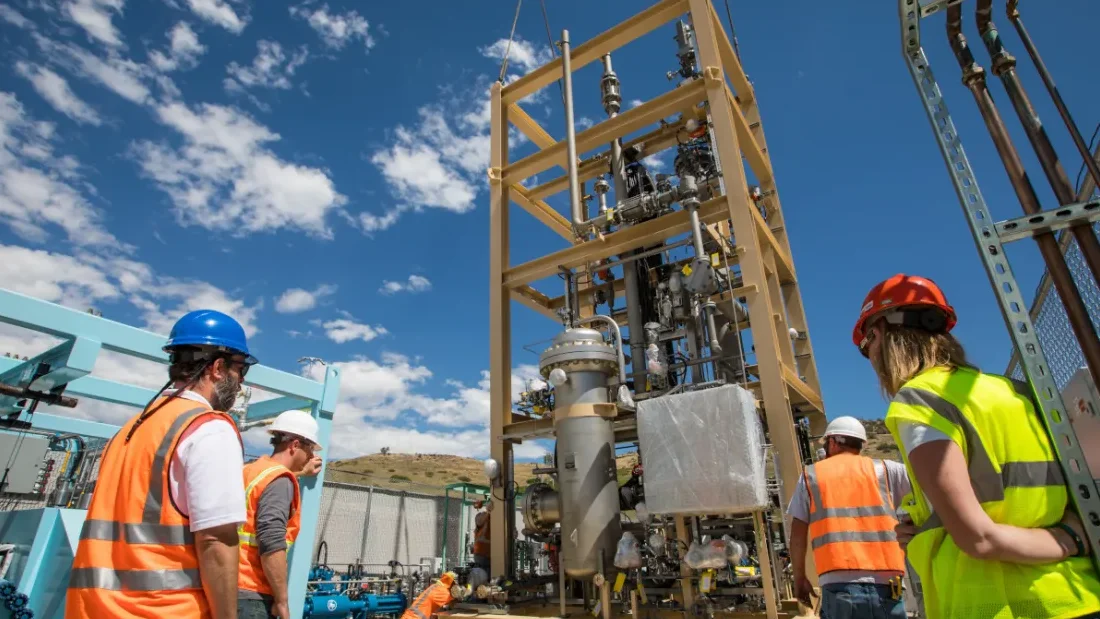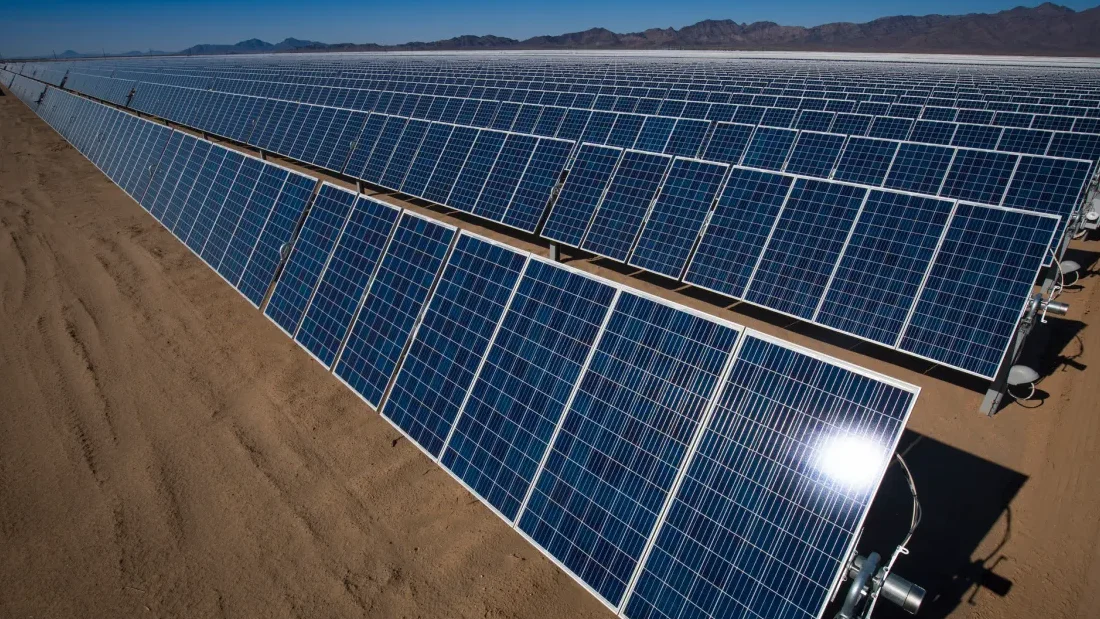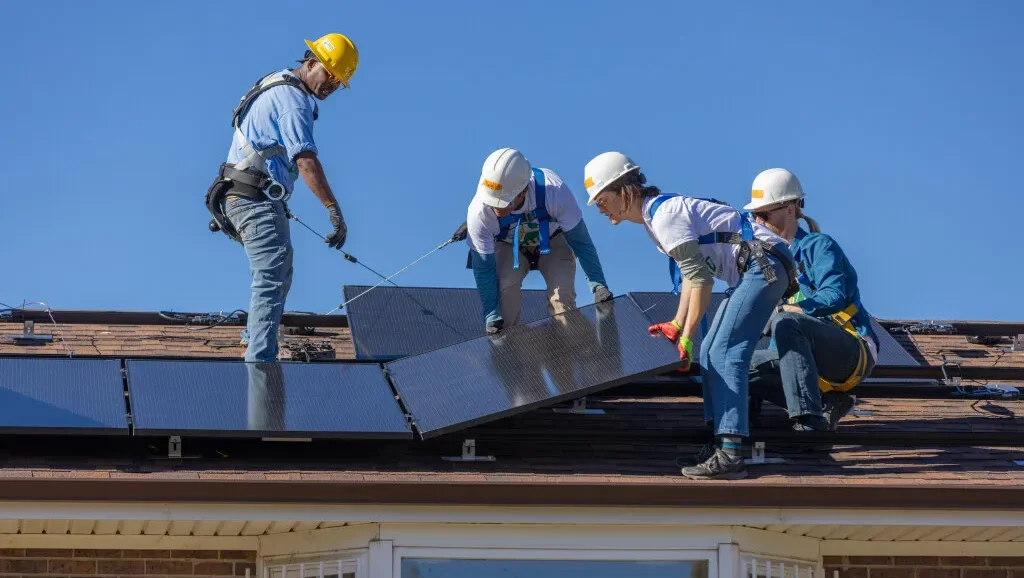
This story was produced in partnership with OpenSecrets, a nonpartisan, nonprofit organization that tracks money in politics. Jimmy Cloutier is the political reporter at opensecrets.org. He can be reached at jcloutier@opensecrets.org.
The number of companies and organizations lobbying the federal government on issues related to hydrogen increased nearly tenfold since President Joe Biden took office — from about two dozen at the end of 2020 to more than 200 this year, according to an OpenSecrets analysis of lobbying disclosures.
Fossil fuel companies, which have promoted hydrogen as a catch-all solution to climate change, rank among the top spenders and outnumber clients from every industry, including the renewable energy sector, the analysis shows.
Thirty-two oil and gas producers reported lobbying on hydrogen, among other issues, and spent a combined $41.3 million on federal lobbying efforts this year, as of Sept. 30.
The lobbying blitz comes as the Biden administration prepares to direct billions of dollars in federal subsidies to scale up hydrogen production to decarbonize the U.S. economy. Unlike coal, oil and gas, hydrogen does not release planet-warming greenhouse gases when burned.
The number of companies and organizations that reported lobbying on issues related to hydrogen has increased tenfold since President Joe Biden, who promised aggressive action on the climate crisis, entered office, according to federal lobbying disclosures.
.png)
Many climate advocates support this move but warn against incentivizing hydrogen projects that could prolong the use of fossil fuels.
It is possible to produce so-called “green hydrogen” using water and renewable energy, but about 95% of hydrogen is currently derived from natural gas, which generates large amounts of climate pollution.
The fossil fuel industry has aggressively lobbied the White House, Congress, and Energy and Treasury departments to ensure gas-based hydrogen qualifies for federal subsidies. The industry claims it can produce climate-friendly “blue hydrogen” from natural gas using carbon capture, a nascent technology still in early development.
In 2022, the American Petroleum Institute, which represents nearly 600 oil and gas companies, submitted comments on the Energy Department’s draft National Clean Hydrogen Strategy and Roadmap emphasizing the near-term cost advantages of blue hydrogen. The industry group’s climate action framework, published the previous year, also called for “full government funding” of low-carbon research and development programs and urged policy-makers to adopt a “technology-neutral” approach to the energy transition.
Julie McNamara, the deputy policy director for climate and energy at the Union of Concerned Scientists, a think tank, told OpenSecrets that the government risks “aiding and abetting fossil fuel” interests.
“There are so many ways that hydrogen can go that it just perpetuates the status quo,” she explained.
“That is an extremely lucrative place for the fossil fuel industry to be,” she said. “If we have weak standards, it can mean more use of natural gas for longer with more profit along the way.”
Climate advocates have urged the Biden administration to enact strict guardrails to ensure hydrogen projects deliver on their climate promises. They want the federal government to prioritize the development of green hydrogen and limit its use to heavy industries that cannot be electrified, like aviation and steel. They also emphasize the need to accelerate the buildout of renewable energy infrastructure to meet the demands of green hydrogen production, which requires a significant amount of electricity.
Getting hydrogen wrong, McNamara added, would be a “catastrophic waste of time.”
Thirty-two oil and gas companies reported lobbying on hydrogen, spending a combined $41.3 million on federal lobby efforts in the first nine months of 2023. Top spenders include several fossil fuel producers that stand to receive billions in federal funding to develop regional clean hydrogen hubs.

In response to interview requests from OpenSecrets, the American Petroleum Institute shared a study it commissioned “on the benefits of low-carbon hydrogen.” The study concluded that “uniform incentives” for blue and green hydrogen would lead to the fastest buildout of hydrogen infrastructure.
The American Petroleum Institute spent nearly $4.5 million lobbying the federal government in the first nine months of 2023.
Companies and industry groups report lobbying on dozens of issues, making it difficult to tell from disclosures how big a priority hydrogen was for oil and gas companies. But several leading fossil fuel producers — such as BP, Chevron and Exxon Mobil — have invested in hydrogen initiatives and made the alternative fuel source a key component of their low-carbon solutions programs.
The companies, which all reported lobbying on hydrogen, also stand to benefit from generous government grants and tax credits intended to phase out fossil fuels.
In October, the Energy Department announced plans to award $7 billion to seven proposed regional hydrogen hubs, including $1.2 billion to a Texas project that counts fossil fuel giants Chevron, Exxon Mobil, Phillips 66 and Shell as partners. BP and Exxon Mobil are also involved in developing a Midwest hub that will receive $1 billion through the same government program.
Three of the hubs awarded federal funding are expected to produce hydrogen from natural gas, according to press releases and publicly available information. The Texas hub will produce hydrogen from natural gas and a renewables-powered electrolyzer, while the Midwest hub will rely on a mix of natural gas, renewable energy and nuclear energy.
A third hub in Appalachia — spanning West Virginia, Ohio and Pennsylvania — will produce hydrogen entirely from natural gas. Project developers include Marathon Petroleum.
In response to requests for comment, a Chevron spokesperson told OpenSecrets that the company is “committed to working with policymakers to help inform well-designed energy policy that effectively reduces greenhouse gas emissions.”
A Marathon spokesperson said the company is seeking “clarity on upcoming regulations.” Other companies named in this article did not respond to requests for comment.
The reaction from climate advocates to the hub announcement was mixed.
“We expected there to be a little more green hydrogen,” said Erik Kamrath, hydrogen policy advocate at the Natural Resources Defense Council. He noted that the Bipartisan Infrastructure and Jobs Act of 2021, which authorized the awards, required only one project producing hydrogen from fossil fuels to be selected.
The awards are still subject to negotiations and environmental reviews, but McNamara said the Energy Department left the door open to “unproductive at best, actively harmful at worst” production methods that rely on natural gas and carbon capture.
“Hydrogen can drive up pollution from fossil-fuel-based uses, and worse, perpetuate ongoing use of fossil fuels,” McNamara said. “That’s not the path we need to be on.”
In an email to OpenSecrets, an Energy Department spokesperson said, “DOE’s Regional Clean Hydrogen Hubs program is essential to achieving the President’s vision of a strong clean hydrogen economy that creates healthier communities, strengthens energy security, and delivers new economic opportunities across the nation.”
The department, which environmental groups have criticized for its lack of transparency, did not answer emailed questions about the hydrogen hubs and instead directed OpenSecrets to online pages containing high-level overview of the agency’s hydrogen hub program and awards negotiation process.
Climate advocates and the fossil fuel industry are also squabbling over additional clean hydrogen tax credits authorized through Biden’s signature climate spending package, the Inflation Reduction Act, passed last year. The tax credit is worth up to $3 per kilogram for hydrogen produced using low-emissions processes.
Green hydrogen produced without fossil fuels is energy-intensive, and climate advocates want to limit the incentive to hydrogen produced using new, rather than existing, clean energy sources.
“We are in a renewables constrained environment,” said McNamara, explaining that if hydrogen production scales up too quickly and relies on existing renewable infrastructure then electricity providers may have to turn to fossil fuels to keep up with energy demands.
Some hydrogen producers and fossil fuel companies who support looser regulations argue that stringent requirements will slow development and delay the U.S. transition to clean energy.
Last week, Bloomberg and Politico reported that leaked draft rules on the tax credits indicated the Biden administration would require producers to rely on newly built renewable energy.
The Treasury Department is expected to formally issue a rule by the end of the year.

CLIMATE: Black Americans’ migration to the Southeast to escape environmental racism and poor health outcomes in the North and Midwest means a growing number of people are moving toward the epicenter of the climate crisis. (Capital B)
BIOMASS: Opponents of a wood pellet producer’s planned Alabama plant cheer reports the company is experiencing a financial crisis that could undercut its plans to expand. (Inside Climate News)
POLITICS:
SOLAR:
STORAGE:
WIND:
ELECTRIC VEHICLES:
NUCLEAR:
OVERSIGHT:
GRID:
UTILITIES: The Tennessee Valley Authority projects the need to boost power production due to rising demand from electric cars, data centers and overall economic growth. (Chattanooga Times Free Press)
COMMENTARY: Indiana should emulate Kentucky’s example and pass a law making it more difficult for utilities to close coal-fired power plants to ensure grid reliability, writes a Republican town council member. (Cleburne Times-Review)

NUCLEAR: California regulators vote to allow the Diablo Canyon nuclear plant to continue operating for five years beyond its scheduled 2025 retirement date. (Associated Press)
OIL & GAS:
CLIMATE:
SOLAR: An Arizona solar panel installation firm ceases operations, lays off dozens of employees and files for bankruptcy. (Phoenix Business Journal, subscription)
TRANSPORTATION: An analysis finds California’s zero-emissions vehicle mandates and other climate programs could lead to a nearly $6 billion decrease in gasoline tax revenues and a shortage of highway repair funds. (CalMatters)
HYDROPOWER: Northwest tribal nations and environmentalists say their $1 billion salmon recovery deal with the Biden administration is a road map for dismantling hydropower dams. (Associated Press)
STORAGE: California’s energy commission awards a firm $30 million to build a long duration iron-air battery storage project near Mendocino. (news release)
UTILITIES:
WIND: A Washington state advisory council will decide next month whether to recommend approval of a controversial proposed 200-turbine wind facility near Kennewick. (Tri Cities Area Journal of Business)
COMMENTARY: California needs to stop bickering over the minutiae of net metering policy and cost-shifting and wholeheartedly embrace rooftop solar to tackle climate change, an energy journalist argues. (Los Angeles Times)

With the federal government preparing to pour money into new regional production hubs and other incentives, the hydrogen industry is positioning itself for takeoff.
But hydrogen technology still hasn’t proven itself to be financially viable, or necessarily all that clean. Hydrogen doesn’t produce greenhouse gas emissions when burned, but making the fuel requires lots of — potentially dirty — energy. Most of it today is made with natural gas. A clean alternative involves a process using water and renewable electricity, but some want to keep using natural gas but with carbon capture — another technology still unproven on a larger scale.
Climate advocates want to keep hydrogen made with fossil fuels from being lumped in with cleaner sources, and say it shouldn’t qualify for forthcoming federal subsidies. Meanwhile, fossil fuel companies and other blue hydrogen backers have launched a federal lobbying blitz in hopes of getting on the Biden administration’s good side, the Energy News Network’s collaboration with OpenSecrets reveals.
Just a few dozen companies and organizations were lobbying the federal government regarding hydrogen when President Biden was elected in late 2020, Jimmy Cloutier of OpenSecrets reports. Now, that number is more than 200, including at least 32 oil and gas producers.
That influence could all have an impact on forthcoming rules governing where federal hydrogen incentives will go, which are expected before the year ends.
Read more from the Energy News Network and OpenSecrets here.
🇺🇲 IRA’s foreign influence: While the Inflation Reduction Act continues to rankle Republican lawmakers, foreign leaders say its “green patriotism” and incentives for domestic clean energy manufacturing provide a blueprint for climate plans they can sell across the political spectrum. (New York Times, Politico)
🔌 EV chargers’ reliability problem: Today’s electric vehicle charging stations largely fall below reliability standards the federal government is requiring they meet before they can access $5 billion in new funding. (Canary Media)
🔋 What’s next for batteries: As more renewables are added to the power grid, researchers are exploring new battery technologies with longer storage durations and more widely available materials than lithium-ion batteries. (Utility Dive)
⚡ Electrification diet: A planning process known as “watt dieting” could enable many homeowners to switch to fully electric appliances without a costly panel upgrade. (Canary Media)
📰 Fake news, fossil fuel edition: At least seven major news outlets create and publish misleading advertisements for fossil fuel companies intended to look like credible editorial content, an analysis finds. (Intercept)
🏭 Stopping smog: A new federal air pollution rule cut smog-forming emissions 18% in 10 states this past summer, and would’ve had a bigger impact if legal challenges hadn’t stopped its implementation in 12 other states. (Grist)
The COP28 climate summit ended yesterday, after disagreements sent negotiations into overtime. Here’s how the U.S. got involved in the last week.

COAL: Appalachian Power considers what to do with the site of a Virginia coal-fired power plant that was shuttered in 2014, and whether it can transport accumulated coal ash there to a West Virginia landfill. (WVTF)
ALSO: Georgia Power presses to keep two coal-fired power plants open a decade longer than planned, despite one’s ranking in a recent study as the second most deadly polluter among U.S. coal plants. (Georgia Public Broadcasting)
STORAGE: Duke Energy disconnects large, Chinese-made batteries at a Marine Corps base in North Carolina after officials express security concerns about the manufacturer’s ties to China’s Communist Party. (Reuters)
SOLAR:
EFFICIENCY: Louisiana regulators prepare to vote on long-awaited energy efficiency rules to require utilities to implement various power-saving measures and technologies. (Louisiana Illuminator)
ELECTRIC VEHICLES:
OIL & GAS:
NUCLEAR:
GRID: A Democrat and a Republican newly elected to the Virginia legislature join a coalition to announce a new state advocacy group that will push for stronger oversight of the state’s booming data center industry. (Richmond Times-Dispatch)
CLIMATE: Florida struggles to deal with dramatically varying amounts of rainfall, from record deluges on its southeast coast to a drought along the Gulf Coast. (Associated Press)
UTILITIES: A columnist explains the confusing methodology behind how utilities pay North Carolina property taxes. (Asheville Watchdog)
COMMENTARY:

SOLAR: Minnesota solar advocates say a recent change in how Xcel Energy manages its substations is unnecessarily limiting solar development. (Energy News Network)
ALSO:
LINE 5:
CO2 PIPELINES:
UTILITIES: Minnesota regulators approve interim electric and gas rate increases for infrastructure and clean energy investments from Xcel Energy and Minnesota Power. (Star Tribune)
GRID: Cuyahoga County in northern Ohio is set to launch what officials say is the first electric microgrid utility in the United States that will build three projects near Cleveland. (Morning Journal)
BIOENERGY:
CLEAN ENERGY: Missouri officials are preparing to distribute millions of dollars in federal funding for grid infrastructure investments, electrification and clean energy work training. (St. Louis Post-Dispatch)
COAL: University of North Dakota researchers say they have found a feasible and economic way to extract critical metals from lignite coal. (MPR)

SOLAR: New U.S. solar installations are expected to reach a record 33 GW by the end of this year, but growth is expected to slow in 2024, according to a new industry report. (Reuters)
ALSO: Minnesota solar advocates say a recent change in how Xcel Energy manages its substations is unnecessarily limiting solar development. (Energy News Network)
CLEAN ENERGY:
CLIMATE:
CARBON CAPTURE: Environmental groups raise concerns about a proposal to store captured carbon dioxide beneath U.S. Forest Service lands. (Floodlight)
OIL & GAS: A new report finds “excess profits” in the oil industry and other sectors exacerbated inflation in 2022. (CNBC)
ELECTRIC VEHICLES:
MATERIALS:
ELECTRIFICATION:
COAL: Georgia Power presses to keep two coal-fired power plants open a decade longer than planned, despite one’s ranking in a recent study as the second most deadly polluter among U.S. coal plants. (Georgia Public Broadcasting)

A year after the federal government promised new rules governing how electric vehicles can qualify for tax credits, the Treasury Department’s official guidance is finally here.
The Biden administration rolled out the guidance last week, including tests to determine if a car contains enough U.S.-made components to qualify for all or some of a $7,500 credit. Vehicles that contain parts or materials from China and a few other countries won’t qualify for full incentives.
The Treasury Department hasn’t yet published a list of what EVs meet the new requirements, which would take effect next year. But an auto industry trade group said the 20 models that currently qualify for federal incentives will continue to do so, E&E News reports.
The new rules could cause problems for Ford and other automakers that have licensed Chinese technology for their EVs. They could lose out on a piece of $6 billion in federal grants for U.S.-made EVs, and sales could suffer in comparison to automakers that qualify for federal tax credits.
Meanwhile, some car buyers could still be apprehensive about the lack of public EV chargers in many parts of the country. Two years ago, Congress allocated $7.5 billion to build tens of thousands of EV chargers, but as Politico reports, the program still hasn’t funded any charger projects, and states and charging companies say complicated requirements to receive the funds are to blame.
How the Biden administration navigates EV chargers, tax credits and more will determine just how quickly Americans decide to swap out their gas cars — and whether the White House can reach its EV deployment goals.
🏭 Methane in the crosshairs: The U.S. EPA unveils new methane emissions standards that will require oil and natural gas producers to upgrade equipment and regularly inspect their pipelines and infrastructure for leaks. (E&E News)
💡 Time to get efficient: The world needs to double the pace at which it’s deploying energy efficiency measures, such as installing heat pumps and LED lightbulbs, if it hopes to meet global climate goals, the International Energy Agency says. (Reuters)
☑️ Biden’s climate to-do list: Environmental advocates release a to-do list of climate actions they want President Biden to take in the last year of his term, including a slew of EPA regulations and other Cabinet-level actions. (Washington Post)
🚘 UAW’s next step: After a successful strike against the Big Three automakers, the United Auto Workers announces plans to organize workers at three non-union electric vehicle companies. (CNN)
☀️ Made in the USA: A solar company says it’ll soon build arrays out of U.S.-produced materials, which could be the first projects to qualify for federal tax credits with domestic production requirements. (Bloomberg)
📉 California’s solar collapse: California rooftop solar installations have plummeted by up to 85% since regulators slashed the rates utilities pay for excess solar power sent back to the grid, according to an industry group. (Canary Media)
👷Tribes turn to solar: Indigenous entrepreneurs in North Dakota and elsewhere are building solar farms on reservations, and training tribal members to install them. (BBC)
World leaders gathered in Dubai last week and through the weekend to discuss climate action. Here are some of the highlights:

This article originally appeared on Planet Detroit.
Advocates across Michigan celebrated last week as Gov. Gretchen Whitmer signed into law a package of energy bills targeting 100% clean power by 2040, positioning Michigan as a national climate leader.
But environmental justice advocates say the legislation, dubbed the “Clean Energy Future” package by supporters, had a major omission by making no provision for community solar, which allows residents to subscribe to third-party-owned solar arrays in exchange for energy bill credits.
The Michigan Environmental Justice Coalition (MEJC) is pushing for the passage of Senate Bills 152 and 153 and House Bills 4464 and 4465, introduced in the spring, which would enable community solar in Michigan.
But so far, none of the bills have come up for a vote, although the House Committee on Energy, Communications and Technology heard testimony on the House bills in November.
“It’s no secret that we are not very happy with the Clean Energy Future package,” Roshan Krishnan, policy associate at MEJC, told Planet Detroit. Krishnan said enabling community solar would accelerate solar buildout in the state and reduce demand for carbon capture and biofuels — polluting technologies included in the bill package — which MEJC opposes.
Backers say community solar, more accessible to lower-income customers and those living in multifamily housing, is crucial to building equity into the energy transition. They tout other benefits like improved energy reliability and lower bills for renters and others who can’t install rooftop solar.
But they say Michigan utilities are wielding their influence and political spending in Lansing to block legislation enabling community solar owned by third parties, even though the concept enjoys bipartisan support.
Michigan’s two largest investor-owned utilities, DTE Energy and Consumers Energy, have long fought laws enabling community solar. They argue such laws are unnecessary and would add costs for other customers. And they’ve spent millions in the last two years to influence lawmakers as such laws were being considered.
According to the U.S. Department of Energy, 22 states and the District of Columbia have policies in place that enable community solar. Most projects are concentrated in four states: Minnesota, New York, Massachusetts and Florida.
Ed Rivet, executive director of the nonprofit Michigan Conservative Energy Forum, told Planet Detroit he believes the public’s increasing embrace of renewable energy could give groups like his leverage to pressure lawmakers to bring community solar to Michigan.
“Part of our work … is to say to legislators, ‘Look, people want to do this in your district. Republicans and Democrats alike want to do this. Go ahead and ask folks in your district and see what you find’,” Rivet said.
Rivet said utilities’ influence in Lansing is the major hurdle to passing community solar legislation.
“If there’s resistance to the legislation being adopted, it’s coming from a singular vantage point, that being the utilities,” he said.
DTE and Consumers are unequivocal in their opposition to community solar. DTE spokesperson Peter Ternes told Planet Detroit the proposed community solar legislation is “unnecessary” and would “allow developers to cherry-pick customers and force the utility’s remaining customers to subsidize the program – challenging affordability for our customers.”
Consumers spokesperson Brian Wheeler also called the legislation “unnecessary,” warning that it would allow “unregulated, out-of-state solar developers” to have “unfiltered access to the grid while pushing for a premium price for their own solar projects at the expense of low-income customers.”
Ternes and Wheeler each endorsed their respective companies’ utility-owned programs, DTE’s MIGreenPower and Consumers’ Solar Gardens, where residents voluntarily charge extra bills to support utility-owned solar developments.
Rivet criticized these programs, noting they are designed so customers pay more for clean energy without receiving a financial benefit for investing in a power source that is cleaner and often cheaper than others.
There’s little doubt utilities are spending resources to influence legislators. Utility watchdog group Energy and Policy Institute revealed that political action committees (PACs) tied to DTE and Consumers gave nearly $500,000 to campaign accounts for Whitmer, state legislators and state party funds in 2023 while renewable energy legislation was being considered, with 80% of legislators taking money from these PACs.
The analysis showed that key Democratic lawmakers received far more than other party members this year. For example, House Speaker Joe Tate (D-Detroit) took $30,000 from utilities, and Senate Majority Leader Winnie Brinks (D-Grand Rapids) received $15,500.
In 2022, DTE-affiliated dark money groups gave $2 million to Democratic groups.
A 2021 study from Michigan State University found that enabling community solar would create thousands of jobs over the next 25 years and bring $1.5 billion in economic benefits.
And advocates say it would better position the state to compete for grants through the $7 billion federal Greenhouse Gas Reduction Fund for projects that reduce or avoid planet-warming emissions, emphasizing low-income and disadvantaged communities.
But they say the greatest potential benefits lie in creating opportunities for low-income residents to lower their energy bills and access more reliable power. Residential customers in Michigan pay the highest rates in the Midwest, and DTE and Consumers are some of the worst utilities in the nation for the duration of blackouts. On Dec. 1, the Michigan Public Service Commission approved a $368 million rate increase for DTE that would add $6.51 to the average customer’s monthly bill.
HB 4464 would require 30% of each community solar project to go to low-income households or service organizations.
In comments to the Michigan House Energy, Communications, and Technology Committee in November, Dr. Elizabeth Del Buono, president of Michigan Clinicians for Climate Action, said community solar would also be a win for public health.
Del Buono said community solar will make the grid more reliable during power outages when paired with battery storage, “thereby protecting the health of vulnerable patients dependent on electricity to breathe and be mobile.”
According to John Richter, senior policy analyst at the nonprofit Great Lakes Renewable Energy Association, additional legislation would be in order if community solar did pass.
That would include raising the state’s “solar cap,” which sets the percentage of peak yearly load that a utility must buy from distributed energy producers.
The Clean Energy Future package raised this number from 1% to 10%, but State Sen. Jeff Irwin (D-Ann Arbor) introduced Senate Bill 362 this year to remove the cap. Irwin’s bill would also restore “net metering,” where rooftop solar customers are credited for energy put back on the grid at the same retail rate they pay for electricity.
Following intense utility lobbying, net metering was replaced by an “inflow-outflow” tariff in 2018, which deducts transmission costs from credits. That change increased the time to recoup up-front costs for the average rooftop solar producer from roughly nine years to 13 years.
Richter said that if these credits aren’t increased, “it would basically be pointless” to try to make community solar projects work economically for residents and developers.
But with Democrats losing their majority in the Michigan House in 2024, community solar may be one of the few energy priorities that could move forward, according to Rivet.
“Because it does have bipartisan support, it at least has a chance of being the next round of dialogue on energy policy,” he said.
Krishnan is less optimistic.
“Nothing is going to move unless the leadership actually steps up to the plate and does it,” he said. “And they’ve shown absolutely no inclination that they are willing to do so, which I think is frankly reflective of their extreme lack of commitment to environmental justice.”

An unlikely collaboration between a Kentucky coalfield county and Kentucky’s largest city began when a former high school English teacher, Megan Downey, walked into the Lawrence County courthouse in Louisa in August.
Inspired by a personal desire to find ways to tackle the impacts of climate change, Downey had launched a nonprofit called The Solar Collaborative last year in Virginia dedicated to helping Appalachian communities transition to renewable energy.
She had been pitching an idea to local governments across Eastern Kentucky: Seek some of the billions in federal funding up for grabs in the Solar for All competition. Through the competition, the U.S. Environmental Protection Agency plans to invest $7 billion through 60 grants to states, local governments, nonprofits and tribal governments to “increase access to affordable, resilient, and clean solar energy for millions of low-income households.” The money comes from the Inflation Reduction Act’s Greenhouse Gas Reduction Fund.
When Downey talked with Deputy Judge-Executive Vince Doty about the opportunity, he agreed “within minutes” to sign up.
“He’s the biggest advocate, I think, in the whole region for this type of project,” Downey said. “A lot of low-income communities don’t have access to that economic savings that’s associated with solar, and so it’s just one more way in which a wealth gap is continuing to increase.”
Doty brought other Eastern Kentucky counties on board for an application to the competition; judge-executives in Lawrence, Johnson, Martin, Floyd, Pike, Boyd, Greenup counties all wrote letters of support. After learning they had both submitted letters of intent to apply for the federal funding, the mountain counties teamed up with Louisville’s government to submit a unified application that could provide affordable access to solar energy for thousands of low-income homes in Kentucky from its largest cities to its rural Appalachian counties.
It’s one of two competing applications from Kentucky. The other was submitted by the Kentucky Energy and Environment Cabinet; solar advocates say it could be a significant boost for the use of residential solar across the state.
Advocates argue more distributed solar, for example via solar panels on rooftops, could mean utility bill savings for Kentuckians and a curbing of greenhouse gas emissions connected to Kentucky’s fossil fuel-reliant electricity grid.
For Doty, seeking funding for solar was foremost about easing the financial burden of his constituents in a region that faces continued economic challenges from the decline of the coal industry. Lawrence County is one of 20 Eastern Kentucky counties served by electric utility Kentucky Power, which has the highest monthly residential utility bills in Kentucky, according to a state analysis.
“We always try to put our citizens first,” Doty said. “If there’s a chance that we can save somebody $300 a month off their electric bill, that’s worth trying for.”
Both the Louisville-Eastern Kentucky and state government proposals are wide in scope, highlighting specific ideas for how to use tens of millions of dollars in federal funding. Both applications could mean integrating solar energy into thousands of homes, whether through direct ownership of rooftop solar installations or better access to existing or planned community solar projects.
The Louisville-Eastern Kentucky application is asking for $150 million to be spent over five years, proposing:
Downey said Doty had advocated in a number of meetings as the Louisville-Eastern Kentucky application was being developed that it was a “non-negotiable” that Kentuckians should own the solar installations themselves
The application anticipates, if awarded funding, at least a 20% energy bill reduction for approximately 7,300 households in Kentucky taking part in the proposal. Households that ultimately receive a six-kilowatt solar installation for free could see energy bill reductions up to 50%, according to the application.
“If you put solar on your home, you immediately have benefits economically from the savings that you garner. It also increases the value of your home,” Downey said. “So this has the potential for a really significant impact if you look at it over 25 years as far as wealth generation goes.”
The Louisville-Eastern Kentucky application estimates the results of the funding would add another approximate 44 megawatts of distributed solar power onto Kentucky’s grid. That would increase distributed solar in the state by about 70%, with 63.5 megawatts of distributed solar already in Kentucky.
The application also estimates about 1,300 “green jobs” will be created through the proposed solar investment. Steve Ricketts, the board chair of the advocacy group Kentucky Solar Energy Society, said while construction work associated with larger, utility-scale solar projects is temporary, ending once the project is completed, those workers also can work on installing solar in their own communities.
“They can be working on homes in their own town, they can be working on businesses and around town. So the two are incredibly complementary, and, frankly, have to go together to make it all work,” Ricketts said.
Sumedha Rao, the executive director of Louisville Metro Government’s Office of Sustainability, said the estimates of solar power added, households helped and renewable energy jobs created through the funding proposal are somewhat conservative and that the impact of the grant could be even more.
Given that Kentucky has historically relied on fossil fuels, she said, a transition to renewables can be a “scary proposition” for some Kentuckians. But she believes the Solar for All grant competition has a lot of upside with helping the state transition economically.
“We really feel like this is something that can have a massive impact for years to come,” Rao said.
The Solar for All application submitted by state officials leads with its own idea of how residential solar can be deployed across the state, particularly in areas hit by devastating floods and tornadoes in recent years.
Requesting $100 million from the Solar for All competition, one of the state’s proposals is to put residential solar and an electricity battery storage system on 850 “disaster recovery” homes that could result in 70% utility bill savings for each home — or up to $1,000 in annual bill savings per home — over the course of 20 years.
For Kenya Stump, the executive director of the state’s Office of Energy Policy, eliminating most of the energy bills is just one way to help people recovering from natural disasters who may have lost every material thing they own.
“If they can live in a home from here on out that is more resilient, that also has the burden of that kind of cost is no longer there — shouldn’t we kind of strive for that?” Stump said.
Stump said in many instances low-income Kentuckians live in homes that are old and energy inefficient, leading to higher energy usage and subsequently higher utility bills. She said by enrolling LIHEAP recipients in community solar programs — such as ones offered by East Kentucky Power Cooperative and Louisville Gas and Electric and Kentucky Utilities (LG&E and KU) — they can get a direct credit on their bill and get more value from the utilized renewable energy.
“The energy regardless of the source will just still leak out” of poorly insulated, inefficient homes, Stump said. “We also hope that this will incentivize the growth of more municipal and utility community solar offerings that would be eligible to have LIHEAP carve-outs as well.”
Some stakeholders involved in the Louisville-Eastern Kentucky application, while supportive of community solar projects in general, were skeptical of using Solar for All funds on such projects out of concerns that some community solar models, specifically LG&E and KU’s “Solar Share” program, subsidize an asset of an investor-owned utility with taxpayer funds.
Stump said while stakeholders may wish some existing community solar projects were designed differently, it’s what is currently offered by Kentucky utilities and “can provide some benefit” to low-income Kentuckians that haven’t been able to take advantage.
The two Kentucky applications submitted to Solar for All do align on ways to boost the workforce needed to install residential solar on homes, though Stump added that developing a renewable energy workforce needs to be paced with the deployment of solar.
“That’s our greatest challenge is to make sure we get the timing right so that it aligns with the deployment of projects. We don’t want to give someone hope, and then there not be any work,” Stump said.
For Stump, the Solar for All competition is just one federal program and incentive among many that will ultimately “shift and transform our energy landscape.”
Lane Boldman, the executive director of the environmental advocacy group Kentucky Conservation Coalition, believes both applications are “really solid” but points out the federal government is only giving out 60 grants. Competition for the grants is stiff: More than 30 states have submitted notices that they’re applying along with a number of local governments and nonprofits across the country.
Lawrence County and Louisville decided to collaborate, in part, to increase the chances that their Solar for All application would get awarded. The stakeholders with Lawrence County and Louisville also tried unsuccessfully to unify their application with the state’s proposal.
Boldman said a big question became if a single grant application could ask for enough funding to cover all of the “great ideas” being proposed for the competition.
“The decision really was that it was better to keep them as two separate applications,” Boldman said. “I have to say that I think both grants are very strong and deserving, and so we just have to wait and see what the federal government decides.”